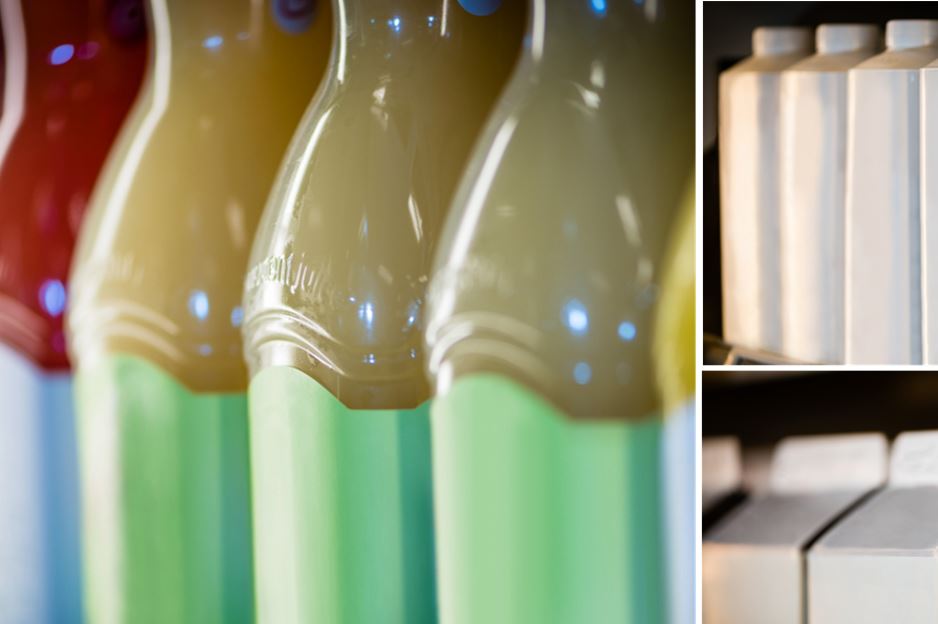Packaging for liquid foods 103
The intention with the criteria is to stimulate the development of sustainable produced renewable materials and use of recycled materials in the packaging.
Packaging for liquid foods is not a traditional Nordic Swan Ecolabelled product, since here it is the actual packaging that is Nordic Swan Ecolabelled, and not the product inside the packaging.
Nordic Swan Ecolabelled packaging for liquid foods:
- Consists of minimum 90% sustainability sourced renewable materials or
minimum 80% recycled material, in order to conserve the Earth's resources
and reduce emissions of greenhouse gases. - Fulfils the high requirements for chemicals, for the benefit of health aspects,
as well as opportunities for recycling. - Can easier be recycled, which promotes the circular economy.
Guidelines for the Nordic Swan Ecolabel on packaging for liquid food
-
Welcome to apply for a Nordic Swan Ecolabel licence!
This is how you do:
- Read the application guide.
- Log in to the Nordic Ecolabelling Portal.
- Start your application.
If this is the first time you are applying, the authorized signatory must fill in your company information and approve the application conditions. In this way, you get login to the portal and the right to assign access to other colleagues.
To the Nordic Ecolabelling Portal
Some special cases can not be done in the Nordic Ecolabelling Portal. Contact your advisor for such cases. More information can be found on "Application step by step".
-
Valid from 1/1 2025
Amount excluding VAT
Application fees
Application for a new licence 3 348 EUR Application for renewal 1 673 EUR Annual licence fee
The licence fee for the Nordic Swan Ecolabelled products is based on their turnover in the Nordic region.
Up to 51.5 million EUR. 0,5% of the products' turnover More than 51.5 million EUR. 0,05% of the products' turnover Minimum fee in the Nordic region 2 232 EUR per year. Fixed fee applicable to turnover outside the Nordic region 2 232 EUR per year for turnover exceeding 300 000 EUR. Fee for extension / change of licence
Fixed fee that is charged depending on how long the work takes.
Up to 4 hours 418 EUR 4-8 hours 836 EUR 8 or more hours 1 673 EUR Fee for on-site inspections
One on-site visit within the Nordic region is included in the application for a new or renewed licence.
Additional on-site inspection within the Nordic region 557 EUR per visit On-site inspection outside the Nordic region, but within Europe 1 673 EUR per visit On-site inspection outside Europe 2 790 EUR per visit Additional fee for on-site inspections lasting longer than one day 1 115 EUR per day For clarification of fees, click here.
Ecolabelling Sweden AB has no financial profit purpose and is financed through the fees above along with an annual government grant. The company is however liable for VAT according to article 56 of the European Council Directive 2006/112/EC.
Invoicing is made in SEK with the exchange rate from the first banking day of the year.
When both the applicant and the manufacturer are micro-enterprises, the application fee is reduced by 50%. A micro-enterprise is in this context defined as an enterprise with less than 10 employees and an annual turnover (of both ecolabelled and not ecolabelled products) below 2 million EUR.
-
-
Criteria documentSwedish / 1.6
-
Writable declarationsSwedish / 1.6
-
Criteria documentEnglish / 1.6
-
Writable declarationsEnglish / 1.6
-
-
Information on the latest version of the criteria for packaging for food liquids
1.5 => 1.6: Prolongation of criteria
On 12 December 2023, Nordic Ecolabelling decided to prolong the validity of the criteria with 12 months to 31 December 2026.
The new version is called 1.6.
1.4 => 1.5: Adjustment of requirements and prolongation of criteria
Nordic Ecolabelling has decided to adjust requirement O2 regarding uncoloured glass and requirement O5 regarding disposable glass. Futhermore, BHT receives a harmonized classification which affects O16 and O17. In addition, the validity of the criteria has been prolonged with 18 months.
The new version is called 1.5 an is valid to 31 December 2025.
1.3 => 1.4: Adjustment of requirements
Nordic Ecolabelling has decided on the following adjustments:
- Requirement O7 regarding exemption for black caps for plastic packaging that is included in deposit systems for beverage packaging
- Requirement O11 regarding change of prohibited wood species
The new version is called 1.4.
1.2 => 1.3: Adjustment of requirement and prolongation of criteria
Nordic Ecolabelling has decided to adjust the exemption for BHT (O17). Furthermore, it has been decided to prolong the criteria with 24 months. The new version is called 1.3 and is valid until 30 June 2024.
1.1 => 1.2: Adjustment of requirements
Nordic Ecolabelling has decided on the following adjustments:
- Requirement O4 regarding migration test requirements (2019-12-10)
- Requirement O17 regarding exemption for BHT (2020-01-17)
- Requirement O18 on colours for printing and dyeing (05/05/2010)
The new version is called 1.2.
1.0 => 1.1: Adjustments of requirement
Nordic Ecolabelling decided on an adjustment regarding an exception in Chapter 4 for date stamping on packaging for liquid food on the 29 May 2019. The new version is called 1.1.
1.0 Adoption of criteria
Nordic Ecolabelling decided on adopting criteria for packaging for food liquids on the 7 November 2018. Version 1.0 is valid until 30 June 2022.
-
-
Background documentSwedish / 1.6
-
Consultation commentsSwedish / 1.6
-
Bakgrund till Bas- och kemikaliemodul 2.8Swedish / 1.6
-
Background documentEnglish / 1.6
-
FAQ Packaging for liquid foods
-
We have a specific Svanen logo that clearly states that it is the packaging that is ecolabelled with Svanen and not the content. We have rules that do not allow this specific Svanen logo to be placed on the front of the packaging. The label also comes with an explanatory text which clarifies this for the consumer.
-
Either the manufacturer of the liquid food or the manufacturer of the packaging can apply and get a license.
-
Most consumers today prefer caps and therefore almost all carton packaging comes with a cap today. In order for the Svanen ecolabel to make a real difference and license a packaging that the consumer wants to buy, we decided to allow plastic corks on the cardboard packaging.
-
We know that the market for plastic packaging will remain, even though many people try to use less plastic in their everyday life. Therefore, the Svanen Ecolabel wants to promote an increased proportion of recycled and / or renewable plastics on the market by only certifying packaging with at least 80 percent recycled and /or renewable plastics, which is higher than the average packaging. The packaging must be recyclable within the existing recycling systems in the Nordic countries. In addition, there are efficient deposit systems for the recycling of PET which is regularly used by consumers.
-
A Svanen ecolabelled PET bottle contains a high proportion of recycled and / or renewable plastic compared to the average bottle. We also have requirements on certification of the raw agricultural material for the renewable plastic and also on additives in the plastic.
-
In order for a glass package to get the Svanen ecolabel, at least 80 percent must be of recycled, unworked glass. Bottles must also be particularly light weight. Clear glass consists of an average of about 45 percent recycled glass. If the percentage of recycled glass is higher, the clarity of the glass is reduced. This means that clear glass can’t get the Svanen ecolabel with current technology, only coloured glass can.
-
An aluminium package with the Svanen ecolabel must consist of at least 80 percent recycled aluminium, which is much higher than the average aluminium can. In addition, the Svanen ecolabel has strict requirements on the additives and chemicals used in the production of the cans. We can see that a large proportion of the aluminium packaging produced today is deposited and recycled by consumers, which the Svanen ecolabel wants to promote.
-
We impose several stringent requirements on the packaging, for example on the chemicals and additives used in the packaging and certification of renewable raw materials. There must be clear routines for quality and sustainability work and the manufacturer must continuously carry out extensive risk assessments of the product's health and environmental impact. One aim is to reduce the risk for migration of dangerous substances to the food.
Furthermore, - The packaging is manufactured with a lower energy consumption in the production of cardboard materials and plastics - Suppliers must actively work on the recycling design - Raw materials in all packaging must be traceable - All materials harvested from forests for cardboard must be FSC-marked
Contact me for more information
- Ulf Eriksson Advisor +46 (0)8-55 55 24 44 ulf.eriksson@svanen.se

